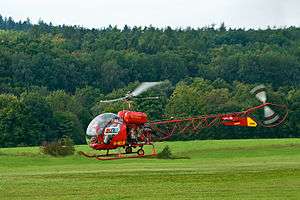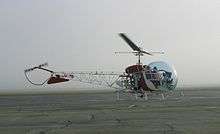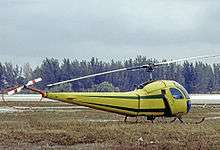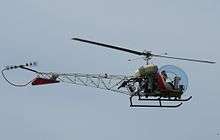Bell 47
| Bell 47 | |
|---|---|
 | |
| Bell 47G | |
| Role | Multipurpose light helicopter |
| National origin | United States |
| Manufacturer | Bell Aircraft / Bell Helicopter |
| Designer | Arthur M. Young |
| First flight | 8 December 1945 |
| Introduction | 1946 |
| Primary users | United States Army British Army |
| Produced | 1946-1974 |
| Number built | 5,600 |
| Developed from | Bell Model 30 |
| Variants | H-13 Sioux Bell 47J Ranger Kawasaki KH-4 |
The Bell 47 is a two-bladed, single engine, light helicopter manufactured by Bell Helicopter. Based on the third Model 30 prototype, Bell's first helicopter designed by Arthur M. Young, the Bell 47 became the first helicopter certified for civilian use on 8 March 1946.[1][2] More than 5,600 Bell 47 aircraft were produced, including those produced under license by Agusta in Italy, Kawasaki Heavy Industries in Japan, and Westland Aircraft in the United Kingdom. The Bell 47J Ranger is a modified version with a fully enclosed cabin and fuselage.
Design and development

Early models varied in appearance, with open cockpits or sheet metal cabins, fabric covered or open structures, some with four-wheel landing gear. Later model D and Korean War H-13D and E types settled on a more utilitarian style. The most common model, the 47G introduced in 1953, can be recognized by the full "soap bubble" canopy,[3] exposed welded-tube tail boom, saddle fuel tanks and skid landing gear.
The later three-seat 47H had an enclosed cabin with full cowling and monocoque tail boom. It was an attempt to market a "luxury" version of the basic 47G. Relatively few were produced.
Engines were Franklin or Lycoming vertically mounted piston engines of 200 to 305 HP (150 to 230 kW). Seating varied from two (early 47s and the later G-5A) to four (the J and KH-4).
As of 2005, many are still in use as trainers and in agriculture.
In April 2011 there were 1068 registered with the Federal Aviation Administration in the United States[4] and 15 in the United Kingdom.[5]
Bell 47s were produced in Japan by a Bell and Kawasaki venture; this led to the Kawasaki KH-4 variant, a four-seat version of the Model 47 with a cabin similar to the Bell 47J. It differed from the "J" in having a standard uncovered tail boom and fuel tanks like the G series. It was sold throughout Asia, and some were used in Australia.
In February 2010, the Bell 47 type certificates were transferred to Scott's Helicopter Services.[6] The sister company that was formed, Scott's - Bell 47, is in the process of starting production of a turboshaft powered version of the Bell 47, the 47GT-6, using a Rolls-Royce RR300 engine and with composite rotor blades, with deliveries planned from 2016.[7]
Operational history
The Bell 47 helicopter entered U.S. military service in late 1946, in a variety of versions and designations for three decades. In the Korean War, it was designated the H-13 Sioux by the U.S. Army, where it served a variety of roles including reconnaissance and scouting, search and rescue, and medevac. It has also served as the helicopter of choice for basic helicopter flight instruction in many countries.
The "Telecopter," a Bell Model 47 rented by television station KTLA in Los Angeles, California, outfitted with a television camera, made the world's first flight by a television news helicopter on July 3, 1958, with its inventor, John D. Silva, aboard. When the television station reported that it was receiving no video, Silva exited the helicopter's cockpit to climb onto its landing skid while it hovered at 1,500 feet (457 m) so that he could investigate the microwave transmitter bolted to its side, where he discovered that a vacuum tube had failed due to vibration and hot weather. After Silva fixed the problem overnight, the Telecopter made the world's first successful television news flight on July 4, 1958.[8]
The San Diego County Sheriff's Department used the Bell 47 when it started its law enforcement helicopter division in 1971.
The National Aeronautics and Space Administration (NASA) had a number of Bell 47s during the Apollo program, used by astronauts as trainers for the lunar lander. Apollo 17 commander Eugene Cernan had a nearly disastrous crash into the Indian River in Florida in 1972, shortly before his flight to the moon.[9]
Records
- 13 May 1949, a Bell 47 set an altitude record of 18,550 feet (5,650 m).[10]
- 21 September 1950, first helicopter to fly over the Alps.[10]
- 17 September 1952, Bell pilot Elton J. Smith set a world distance record for piston helicopters of 1,217 miles (1,959 km) by flying nonstop from Hurst, Texas, to Buffalo, New York.[10] As of 2013, this record still stands.[11]
Variants
- Section source: Complete Encyclopedia[12]
Civilian
- Bell 47
- Pre-production version, powered by a 133-kW (178-hp) Franklin piston engine.
- Bell 47A
- Improved version of the Bell 47, powered by a 117-kW (157-hp) Franklin O-335-1 piston engine.
- Bell 47B
- Equivalent to the military YR-13/HTL-1, powered by the Franklin O-335-1 piston engine.
- Bell 47B-3
- Agricultural/utility version with open crew positions. Also, offered in a version to the US Postal Service as the Bell "Airmailer" .[13]
- Bell 47C
- Bell 47D
- First to appear with a moulded 'soap bubble' canopy, as described by Arthur M. Young himself in video recollections.
- Bell 47D-1
- Introduced in 1949, it had an open tubework tailboom reminiscent of the Bell Model 30, ship number 3, and a three-seat configuration.
- Bell 47E
- Powered by a 149-kW (200-hp) Franklin 6V4-200-C32 engine.
- Bell 47F

- Bell 47G
- Combines a 149 kW Franklin engine with the three-seat configuration of the 47D-1 and introduced the twin saddle-bag fuel tank configuration.
- Bell 47G-2
- Powered by the Lycoming VO-435 engine. Produced under license by Westland Aircraft as the Westland Sioux, for the UK military.
- Bell 47G-2A
- Powered by a 179 kW version of the VO-435.
- Bell 47G-2A-1
- Wider cabin, improved rotor blades and increased fuel capacity.
- Bell 47G-3
- Powered by a supercharged 168 kW Franklin 6VS-335-A.
- Bell 47G-3B
- Powered by a turbocharged 209 kW Avco Lycoming TVO-435.
- Bell 47G-4
- Three-seat helicopter powered by an Avco Lycoming VO-540 engine.

- Bell 47G-5
- A three-seat, utility version. A two-seat agricultural version was later known as the Ag-5. The 47G-5 was the last model to be produced by Bell.
- Bell 47H-1
- A three-seat version with an enclosed cabin and fuselage.[14]
- Bell 47J Ranger
- A four-seat version powered by an Avco Lycoming VO-435 engine.[14]
- Bell 47K
- Military two-seat training variant of the 47J.
Military
- See H-13 Sioux
Licensed versions

- Agusta A.115
- [15][16] 1971 Italian prototype of a Bell 47J with an unclad, tubular tail boom, and powered by a Turbomeca Astazou II turboshaft engine
- Meridionali/Agusta EMA 124
- Italian prototype with redesigned forward fuselage. Not produced.
- Kawasaki KH-4
- Japanese production version with redesigned, lengthened cabin, and redesigned control system
Conversions
- Carson Super C-4
- El Tomcat Mk.II
- Bell 47G-2 modified extensively for agricultural spraying by Continental Copters Inc. First flew in April 1959. Followed by further improved versions.
Operators
Military operators
- For all military operators, regardless of the actual model, see Bell H-13 Sioux operators
Government operators
- Los Angeles City Fire Department[21]
- Los Angeles Police Department[21]
- New York City Police Department[22][23]
Aircraft on display

- Brazil
- Canada
- Alberta Aviation Museum in Edmonton, Alberta is restoring a 47G Model.[25]
- Aero Space Museum of Calgary has a Bell 47G on display.[26]
- Canada Aviation and Space Museum, in Ottawa, Ontario, has a Bell 47 on display, as well as a removed cockpit section for visitors to sit in.[27]
- Canadian Bushplane Heritage Centre in Sault ste Marie, Ontario, has a Bell 47D on display.[28]
- Malta
- Bell 47G-2 AS7201 of the Armed Forces of Malta was formally retired on May 30, 2008 and donated to the Malta Aviation Museum at Ta'Qali.
- South Africa
- South African Air Force Museum - Bell 47G Sioux Mk.2 (ex RAF XT562)[29]
- Sweden
- ABBA: The Museum in Stockholm has a Bell 47G on display that had previously been featured on the cover for ABBA's 1976 album Arrival.[30][31]
- Peru
- Peruvian National Police - Air Police Base in Callao, has a Bell 47G at the main gate and another one in display inside the Base.
- United Kingdom
- A Westland Sioux is on display at The Helicopter Museum in Weston-super-Mare.[32]
- North East Aircraft Museum, Tyne & Wear, has a Bell 47D under restoration as of November 2010.
- Newark Air Museum, Winthorpe, Nottinghamshire, has a Westland Sioux on display as of May 2011

- United States
- Yanks Air Museum in Chino, California has an OH-13E (51-14175) on display.[33]
- Fantasy of Flight in Polk City, Florida has a Bell 47G on display.
- Steven F. Udvar-Hazy Center, Washington Dulles International Airport in Chantilly, Virginia, includes a Bell 47 and the Bell Model 30 predecessor.
- Museum of Modern Art (MoMA) in New York City has a Bell 47D-1 on permanent display.[34]
- US Army Aviation Museum, Fort Rucker, Alabama - 3 OH13s are displayed in the main hall.
- The American Helicopter Museum & Education Center in West Chester, Pennsylvania has a restored Bell 47D1 converted to an H-13 and painted in "M*A*S*H"configuration.[35]
- The Museum of Modern Art (MoMA) in New York City has a Bell 47D1 on permanent display.[36]
Survivors
- Australia
- Austria
- Red Bull — The Flying Bulls — Hangar-7 in Salzburg flies a Bell 47 G-3B-1 (Soloy turboshaft conversion).[38]
- India
- Pushpaka Aviation in Mumbai operates a G-2, a G-3 B2 and a G5 for crop dusting and aerial seeding.[39]
- New Zealand
- United States
- EAA AirVenture Museum in Oshkosh, Wisconsin, has multiple Bell 47 helicopters available to ride.[41]
- Fantasy of Flight in Polk City, Florida has a Bell 47G with a "M*A*S*H" paint scheme.[42]
Specifications (Bell 47G-3B)

Data from International Directory of Civil Aircraft[14]
General characteristics
- Crew: 1 or 2
- Capacity: 1 passenger or 2 litters
- Length: 31 ft 7 in (9.63 m)
- Rotor diameter: 37 ft 2 in (11.32 m)
- Height: 9 ft 3 in (2.83 m)
- Disc area: 1,085 sq ft (100.8 m²)
- Empty weight: 1,893 lb (858 kg)
- Useful load: 1,057 lb (482 kg)
- Max. takeoff weight: 2,950 lb (1,340 kg)
- Powerplant: 1 × Lycoming TVO-435-F1A flat, six-cylinder, reciprocating engine, 280 hp (210 kW)
Performance
- Maximum speed: 91 knots (105 mph, 169 km/h)
- Cruise speed: 73 knots (84 mph, 135 km/h)
- Range: 214 nmi (245 mi, 395 km)
- Rate of climb: 860 ft/min (4.37 m/s)
Notable appearances in media
See also
- Related development
- Agusta A.115
- Bell 47J Ranger
- Bell 201/XH-13F
- Bell 207 Sioux Scout
- Bell H-13 Sioux
- Continental Copters El Tomcat
- Kawasaki KH-4
- Meridionali/Agusta EMA 124
- Aircraft of comparable role, configuration and era
- Related lists
References
Notes
- ↑ "Bell Helicopters". Helicopter History Site.
- ↑ "Biography of ARTHUR MIDDLETON YOUNG".
- ↑ Arthur M. Young. Arthur Young on the Helicopter (Part 2) (YouTube). Arthur M. Young. Event occurs at 10:15 to 11:45. Archived from the original (YouTube) on December 10, 2010. Retrieved April 8, 2016.
I thought the bubble was a great idea, and we tried it. It consisted of taking a large sheet of Plexiglas, and a plywood form, cut for the final dimension for the outside of the bubble, then heating the Plexiglas, putting it under the plywood form, letting air pressure come up through the middle, and it would blow just like a soap bubble. And, then we had a gauge saying how far to blow, and when it reached that point, we turned off the air pressure.
- ↑ FAA
- ↑ CAA
- ↑ Bell Helicopter (February 2010). "Certificate transfer boosts support of Model 47". Shephard Group Limited. Retrieved 10 June 2011.
- ↑ Majumdar, Dave (6 March 2013). "HELI-EXPO: 1950s Era Bell Model 47 helicopter to return to production". Flighglobal. Retrieved 8 March 2013.
- ↑ Pool, Bob, "Obituary: John D. Silva, 92; TV Engineer Devised the World's First News Helicopter," The Washington Post, December 11, 2012, Page B6.
- ↑ "The Helicopter that Fell to Earth, Gene Cernan's Bell 47 Crash, January 23, 1971". Check-Six.com.
- 1 2 3 McGowen, p. 56.
- ↑ "FAI Record ID #976" Record date 17 September 1952, Fédération Aéronautique Internationale. Accessed: 18 November 2013.
- ↑ Donald, David, ed. "Bell Model 47". The Complete Encyclopedia of World Aircraft. Barnes & Noble Books, 1997. ISBN 0-7607-0592-5.
- ↑ "The Bell Airmailer", July 1947, Popular Mechanics bottom of page 78
- 1 2 3 Frawley, page 42
- ↑ Taylor, M. J. H. (1989). Jane's encyclopedia of aviation. London: Studio Editions. p. 40. ISBN 1-85170-324-1.
- ↑ Simpson, R. W. (1998). Airlife's Helicopters and Rotorcraft. Ramsbury: Airlife Publishing. p. 37.
- ↑ "Italy Paramilitary Police Aviation". aeroflight.co.uk. Retrieved 7 February 2013.
- ↑ "Inaugurato il Museo Storico del Servizio Aereo della Guardia di Finanza". .elicotteriweb.it. Retrieved 7 February 2013.
- ↑ "AB 47 Vigili del Fuoco". Retrieved 7 February 2013.
- ↑ "Vigili del Fuoco Agusta / Agusta-Bell AB 47 I-VFEN". Retrieved 7 February 2013.
- 1 2 "Helicopter Market 1973 pg. 264". Flightglobal Insight. 2015. Retrieved January 4, 2015.
- ↑ "Helicopter Market 1968 pg. 59". flightglobal.com. Retrieved 1 January 2015.
- ↑ "New York Police Bell-47D". Demand media. Retrieved 7 February 2013.
- ↑ Museu Aeroespacial (n.d.). "AERONAVES EM RESERVA TÉCNICA \ EM RESTAURAÇÃO". Archived from the original on 16 July 2011. Retrieved 21 July 2011.
- ↑ "Bell 47G (1970)". Alberta Aviation Museum. Retrieved 19 August 2016.
- ↑ "BELL 47G". Aero Space Museum of Calgary. The Aero Space Museum Association of Calgary. Retrieved 19 August 2016.
- ↑ "Bell 47G HTL-6 – Canada Aviation and Space Museum". Aviation.technomuses.ca. Retrieved 2013-02-05.
- ↑ "Bell 47D - CBHC". Bushplane.com. Retrieved 2013-02-05.
- ↑ "History of the Port Elizabeth SAAF Museum". Retrieved 27 May 2013.
- ↑ Rolander, Niclas (2 May 2013). "Gimme! Gimme! Gimme!... An ABBA Museum in Stockholm". Wall Street Journal. Retrieved 17 July 2016.
- ↑ "On the Museum". ABBA: The Museum.
- ↑ The Helicopter Museum, the World's Largest Dedicated Helicopter Museum
- ↑ "Yanks Korea". yanksair.com. Retrieved 2016-05-18.
- ↑ Arthur Young. Bell-47D1 Helicopter. 1945
- ↑ Mobile Army Surgical Hospital (M.A.S.H.)
- ↑ "Bell-47D1 Helicopter". Museum of Modern Art. Museum of Modern Art. Retrieved 19 August 2016.
- ↑ Melbourne CBD Helicopter Tour
- ↑ 50 years Bell 47 "Soloy" of the Flying Bulls
- ↑ "Fleet". Pushpaka Aviation. Retrieved 11 July 2012.
- ↑ M*A*S*H Chopper Scenic Flight Archived July 24, 2011, at the Wayback Machine.
- ↑ AirVenture Museum - Pioneer Airport
- ↑ "1954 Bell 47G". Fantasy of Flight. Fantasy of Flight. Retrieved 19 August 2016.
Bibliography
- Donald, David (1997). The Complete Encyclopedia of World Aircraft. NY, NY: Barnes & Noble. ISBN 0-7607-0592-5.
- Frawley, Gerard (2003). The International Directory of Civil Aircraft, 2003-2004. Fyshwick, ACT, Australia: Aerospace Publications Pty Ltd. ISBN 1-875671-58-7.
- Jane, Fred T; Taylor, Michael John Haddrick (1989). Jane's encyclopedia of aviation. New York: Portland House. ISBN 0-517-69186-8.
- Mutza, Wayne. H-13 Sioux Mini in Action. Carrollton, TX: Squadron/Signal Publications, 1995. ISBN 0-89747-345-0
- McGowen, Stanley S. Helicopters: An Illustrated History of Their Impact. Weapons and warfare series. Santa Barbara, Calif: ABC-CLIO, 2005. ISBN 1-85109-468-7
- Pelletier, Alain J (1992). Bell aircraft since 1935. Annapolis, Md: Naval Institute Press. ISBN 1-55750-056-8.
- Riley, David (February 1958). "French Helicopter Operations in Algeria". Marine Corps Gazette. pp. 21–26.
- Shrader, Charles R. (1999). The first helicopter war: logistics and mobility in Algeria, 1954-1962. Westport, CT: Praeger. ISBN 0-275-96388-8.
- Spenser, Jay P. (1998). Whirlybirds a history of the U.S. helicopter pioneers. Seattle: University of Washington Press in association with Museum of Flight. ISBN 0-295-98058-3.
- United States, Headquarters Department of the Army, Army Concept Team in Vietnam. Final Report of Essential Load of Scout Helicopters. Saigon, Vietnam: Army Concept Team in Vietnam, 1966.
External links
| Wikimedia Commons has media related to Bell 47. |
- Model 47G Museum site
- Model 47G specs from The International Directory of Civil Aircraft by Gerard Frawley
- Scott’s – Bell 47, Inc the current type certificate holder